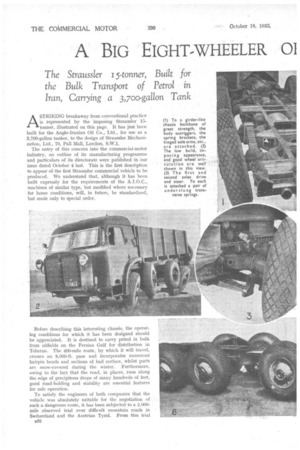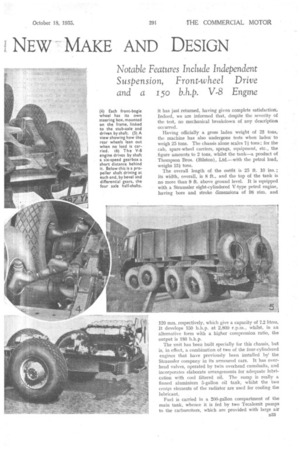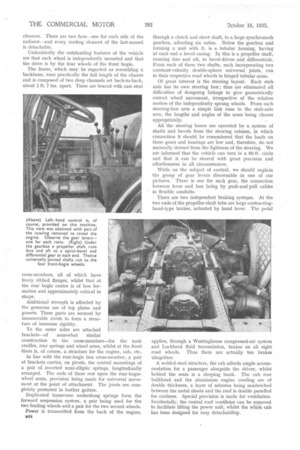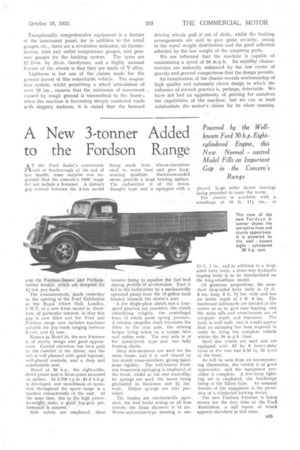A BIG EIGHT-WHEELER 01
Page 46

Page 47

Page 48

Page 49

If you've noticed an error in this article please click here to report it so we can fix it.
NEW MAKE AND DESIGN
ASTRIKING breakaway from conventional practice is represented by the imposing Straussler 15tonner, illustrated on this page. It has just been built for the Anglo-Iranian Oil Co., Ltd., for use as a 3,700-gallon tanker, to the design of Straussler Mechanization, Ltd., 70, Pall Mall, London., S.W.1.
The entry of this concern into the commercial-motor industry, an outline of its manufacturing programme and particulars of its directorate were published in our issue dated October 4 last. This is the first description to appear of the first Straussler commercial vehicle to be produced. We understand that, although it has been built expressly for the requirements of the A.I.O.C., machines of similar type, but modified where necessary for home conditions, will, in future, be standardized, but made only to special order.
Before describing this interesting chassis, the operating conditions for which it has been designed should be appreciated. It is destined to carry petrol in bulk from oilfields on the Persian Gulf for distribution in Teheran. The 400-mile route, by which it will travel, crosses an 8,000-ft. pass and incorporates numerous hairpin bends and sections of bad surface, whilst parts are snow-covered during the winter. Furthermore, owing to the fact that the road, in places, runs along the edge of precipitous drops of many hundreds of feet, go6d road-holding and stability are essential features for safe operation.
To satisfy the engineers of both companies that the vehicle was absolutely suitable for the negotiation of such a dangerous route, it has been subjected to a 2.000mile observed trial over difficult mountain roads in Switzerland and the Austrian Tyrol. From this trial B32 it has just returned, having given complete satisfaction. Indeed, we are informed that, despite the severity of the test, no mechanical breakdown of any description occurred.
Having officially a gross laden weight of 23 tons, the machine has also undergone tests when laden' to weigh 25 tons. The chassis alone scales 7i tons ; for the cab, spare-wheel carriers, sprags, equipment, etc., the figure amounts to 2 tons, whilst the tank—a product of Thompson Bros. (Bilston), Ltd.—with the petrol load, weighs 13i tons.
The overall length of the outfit is 25 ft. 10 ins. ; its width, overall, is 8 ft., and the top of the tank is no more than 9 ft. above ground level. It is equipped with a Straussler eight-cylindered V-type petrol engine, having bore and stroke dimensions of 98 Min. and
120 ram. respectively, which give a capacity of 7.2 litres. It develops 150 b.h.p. at 2,800 r.p.m., whilst, in an alternative form with a higher compression ratio, the output is 180 b.h.p.
The unit has been built specially for this chassis, but is, in effect, a combination of two of the four-cylindered engines that have previously been installed by' the Straussler company in its armoured cars. It has overhead valves, operated by twin overhead camshafts, and incorporates elaborate arrangements for adequate lubrication with cool filtered oil. The sump is really a finned aluminium 5-gallon oil tank, whilst the two centre elements of the radiator are used for cooling the lubricant.
Fuel is carried in a 200-gallon compartment of the main tank, whence it is fed by two Tecalemit pumps to the carburetters, which are provided with large air B33 cleaners. There are two fans—one for each side of the radiator—and every cooling element of the last-named is detachable.
Undoubtedly the outstanding features of the vehicle are that each wheel is independently mounted and that the drive is by the four wheels of the front bogie.
The frame, which may be regarded as resembling a backbone, runs practically the full length of the chassis and is composed of two deep channels set back-to-back, about 1 ft. 7 ins. apart. These are braced with cast steel cross-members, all of which have freely ribbed flanges, whilst that at the rear bogie centre is of box formation and approximately cubical in shape.
Additional strength is afforded by the generous use of top plates and gussets. These parts are secured by innumerable rivets to form a structure of immense rigidity.
To the outer sides are attached brackets—of somewhat similar construction to the cross-members—for the tank cradles, rear springs and wheel arms, whilst at the front there is, of course, a structure for the engine, cab, etc.
In line with the rear-bogie box cross-member, a pair of brackets carries, on pivots, the central mountings of a pair of inverted semi-elliptic springs, longitudinally arranged. The ends of these rest upon the rear-bogiewheel arms, provision being made for universal movement at the point of attachment. The joints are completely protected in leather gaiters.
Duplicated transverse underslung springs form the forward suspension system, a pair being used for the two leading wheels and a pair for the two second wheels.
Power is transmitted from the back of the engine, through a clutch and short shaft, to a large synchromesh gearbox, affording six ratios. Below the gearbox and forming a unit with it, is a tubular housing, having at each end a bevel casing. In this is a propeller shaft, running fore and aft, to bevel-drives and differentials. From each of these two shafts, each incorporating two constant-velocity double-sphere universal joints, run to their respective road wheels in hinged tubular arms. Of great interest is the steering layout. Each stub axle has its own steering box ; thus are eliminated all difficulties of designing linkage to give geometrically correct wheel movement, irrespective of the relative motion of the independently sprung wheels. From each steering-box arm a simple link runs to the stub-axle arm, the lengths and angles of the arms being chosen appropriately.
AU the steering boxes are operated by a system of shafts and bevels from the steering column, in which connection it should be remembered that the loads on these gears and bearings are low and, therefore, do not materally detract from the lightness of the steering. We are informed that the vehicle can turn in a 60-ft, circle, and that it can be steered with great precision and effortlessness in all circumstances.
While on the subject of control, we should explain the group of gear levers discernable in one of our pictures. There is one for each gear, the connection between lever and box being by push-and-pull cables in flexible conduits.
There are two independent braking systems. At the two ends of the propeller-shaft tube are large contracting.. band-type brakes, actuated by hand lever. The pedal applies, through a Westinghouse compressed-air system and Lockheed fluid transmission, brakes on all eight road wheels. Thus there are actually ten brakes altogether.
A welded-steel structure, the cab affords ample accommodation for a passenger alongside the driver, whilst behind the seats is a sleeping bunk. The cab rear bulkhead and the aluminium engine cowling are of double thickness, a layer of asbestos being sandwiched between the metal sheets and the roof is double panelled for coolness. Special provision is made for ventilation. Incidentally, the central roof ventilator can be removed to facilitate lifting the power unit, whilst the whole cab has been designed for easy detachability.
Exceptionally comprehensive equipment is a feature of the instrument panel, for in addition to the usual gauges, etc., there are a revolution indicator, oil thermometers, inlet and outlet temperature gauges, and pressure gauges for the braking system. The tyres are 12.75-in. by 207in. Goodyears, and a highly unusual feature of the wheels is that they are made of Yalloy.
Lightness is but one of the claims made for the general layout of this remarkable vehicle. The suspension system, whilst permitting a .wheel articulation of over 18 ins., ensures that the minimum of movement caused by rough ground is transmitted to• the frame ; when the machine is traversing steeply cambered roads pith slippery surfaces, it is stated that the forward driving wheels pull it out of skids, whilst the braking arrangements are said to give great security, owing to the equal weight distribution and the good adhesion afforded by the low weight of the unsprung parts.
We are informed that the machine is capable of maintaining a speed of 38 m.p.h. Its stability characteristics are naturally enhanced by the low centre of gravity and general compactness that the design permits. An examination of the chassis reveals workmanship of high quality and extremely clever design in which the . influence of aircraft practice is, perhaps, detectable. We have not had an opportunity of proving for ourselves the capabilities of the machine, but we can at least substantiate the maker's claims for its silent running.




























































































